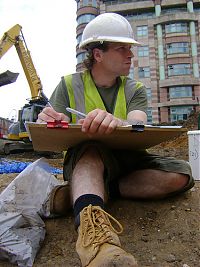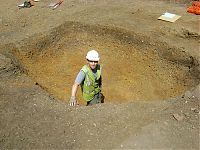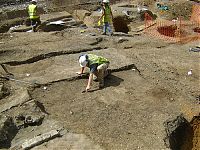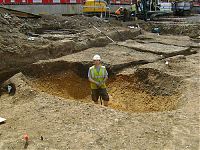Pit with a life of its own
- By: Gregory Crees |
- Aug 01, 2008
- Share
- del.icio.us

I’ve spent the last couple of days mattocking and shoveling (also known as carefully excavating) a huge quarry pit Context: 1469 with Anies and Adrian. This was one of the features revealed during the course of cleaning back a large area of material which included the excavation of the brown material Context: 1443 which I mentioned in my last blog.
The pit took on a life of its own from its initial appearance of a dark blob a couple of metres square in area to some 6m x 4m as we chased its edges back. In depth it was only about 1.40m deep, so it didn’t turn out to be as deep as some other pits we’ve previously excavated on site but it did get pretty heavy going when we got down to the deeper, stonier fills.
It also revealed a couple of disturbed cremation urns: Context: 1474 and Context: 1501, so it fits in with previous our experiences of excavating these big quarry pits elsewhere on the site (since we’ve found other disturbed urns in previously excavated pits). How do I know they were cremation urn burials if they are out of their original context? Well, simply because they were both large (but broken) lumps of pottery. Moreover, they were the bases of pottery vessels, so easily distinguishable as separate vessels (if they were pieces of pot from, for example, the side or upper part of an urn, it may have been harder to identify them as burial urns, especially since it would have been unlikely that bone and soil would still have been attached – the base part of the vessel still acts as a partial container for what remains of the burnt bone and burial ashes, whereas the side of a broken pot would not). A coin was found attached to the contents of Context: 1474. Obviously, they are contaminated with the fill of the rest of the pit, so identification will be harder when they are fully recorded in the lab. Context: 1501 actually came from a layer of dark soil Context: 1499 which the pit cut into, so this is something else that needs to be investigated.
Okay, so I’ve ended up talking about burial urns in my blog once again, but I was actually more interested in saying how the identification and subsequent excavation of pit Context: 1469 has rewarded us with a window into the underlying features that immediately surround it (visible in section in the side of the pit.
Right now, I’ve just cleaned up a gravelly layer Context: 1503 that had been mostly cut away by the pit but could relate to the gravelly surface previously recorded in the vicinity as Context: 1443. Possibly these gravels will prove to be related. In the mean time, its excavation will surely enable me to trace some edges to guess what? More pits which lay below.



